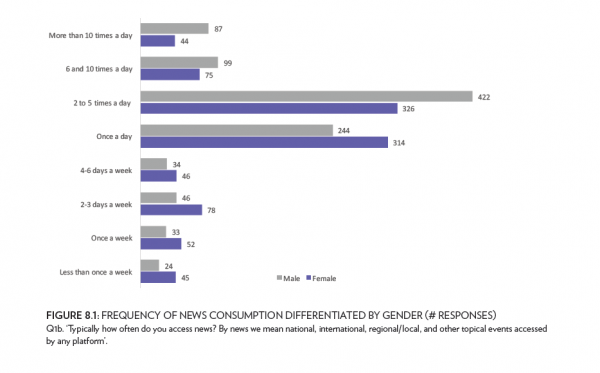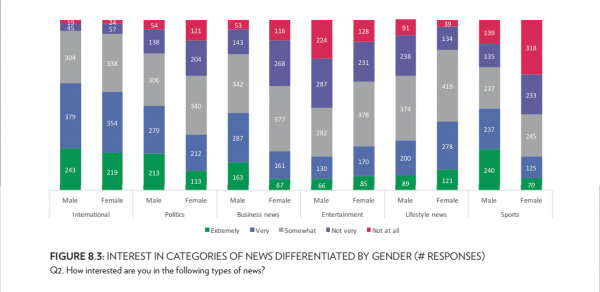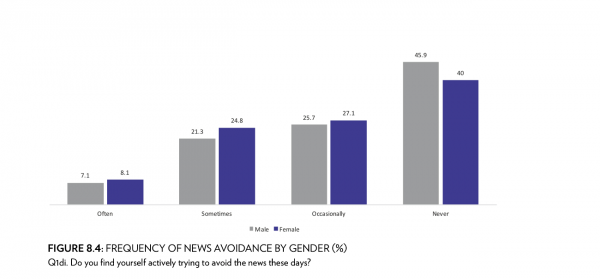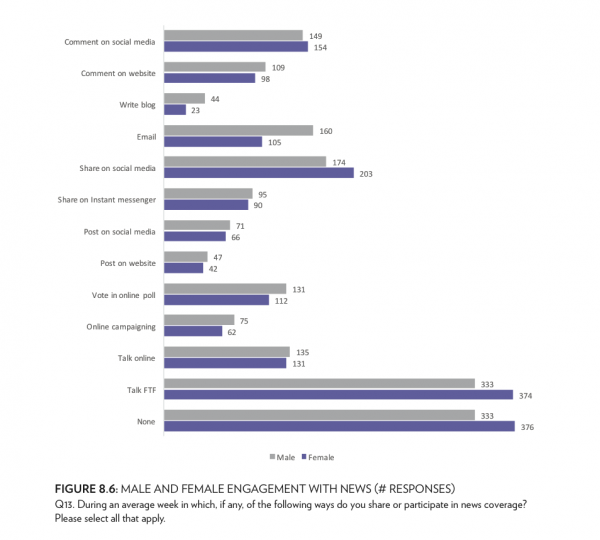The data from our survey provide evidence of gender-based differences in both how and where men and women engage with the news. These results also might provoke an interrogation into how news is presented, and whether different domains of news address the concerns of women and men differentially. Specifically we find the following:
- Overall, men are more likely than women to consume news multiple times a day.
• The most common place for women to consume news is in communal spaces at home; elsewhere in the house they tend to be more nomadic news consumers using smartphones and tablets.
• More men use their smartphone or tablet to consume news in the bathroom or toilet than women use mobile devices to access news at work.
• Both men and women claim to avoid news but men claim to avoid news mostly as a means of asserting control over their lives, whereas women tend to cite more emotional reasons.
• Differences in the kinds of news men and women are interested in are most significant among soft news categories.
The portability of news and the continuous news cycle increase the flexibility of news access, which may make news consumption fit better into gendered household routines. The increased choice of when and how a consumer can access news also means those women who may have previously been restricted by household schedules now have a greater ability to fit news into their daily lives. This may also mean that both men and women increase the frequency of their news consumption.
In earlier times the static schedule of news broadcasts and the delivery of print news led to fairly regularized intervals of news consumption which were long believed to favour men as more avid consumers of news than women, owing to traditional gendered distributions of labour in the home which often permitted men to consume news while women were preoccupied with domestic tasks.
But today the ready availability of news online has changed the temporalities and spatialities of news consumption and therefore the behaviours of some of our survey respondents around how, when, and where they access news.
News consumption
News consumption was measured on a scale ranging from 10 or more times per day to less than once a week. The responses were differentiated by gender. A very clear pattern appears: men are more likely to consume news more than once per day whereas women are more likely to consume news once a day or less, as Figure 8.1 indicates. If we consider age as a function of news consumption, we find that younger news consumers are among the most active as are those in the highest income brackets.
For those survey participants who are highly interested in news, there is little difference in interest between males and females among the 45+ years age groups. Females and younger participants tend to use social media for news consumption whereas males nominate newspapers and online news as their main sources of news. Females, older participants and those with less formal education were most interested in news about crime, justice and security as were rural participants (see Access & Consumption section).
 Gendered spaces
Gendered spaces
The spaces in which women and men access news may impact how they consume it and the extent to which they are likely to focus without interruptions. Specifically looking at digital technologies and the greater portability than, for example, television and sometimes radio, we can examine the extent to which patterns of news consumption are divided by gender. Respondents were asked about their use of a computer (desktop or laptop), a smartphone, and a tablet across a variety of spaces where daily life takes place. These include: at work; at home in a bathroom or toilet; in communal spaces of the home, such as family areas; in personal spaces at home, such as a study or private reading area; in bed, while outside when out and about; and while travelling on both private and public transport.
These patterns reveal significant differences across spaces, as well as across technologies in those spaces. The most common area of news consumption is communal space (see Figure 8.2). This is the only space where women consume news more than men (note: slightly more women consume news in bed than men but this difference is not statistically significant).
In contrast to communal spaces, private spaces in the home tend to be more used by men to consume news, and they are more inclined than women to use a computer in these spaces. In general, women tend to use portable devices to consume news at home which suggests a more nomadic engagement with news than is the case for men.
The main exception to that is in the toilet where more men use smartphones and tablets than women use either of these devices to access news while they are at work. The workplace is one of the spaces where we find the biggest gender differences in news consumption. This may reflect occupational differences between men and women.
Subjects of news interest
Not only are men and women consuming news at different rates and in different spaces, Figure 8.3 shows that they tend to be more interested in different subjects when they consume the news.
These data show that men tend to express more interest in ‘hard news’ such as politics, international news, or business news while women tend to consume more ‘soft news’ such as entertainment and lifestyle news. However, these differences should not be overdrawn.
If we combine those who are very interested and those who are extremely interested across each of these categories of news, we find that there is broader interest in international news for both genders than in either of the soft news categories. Further, based on gendered patterns of socialisation, sports news may be thought of as a form of soft news and men are extremely or very interested in sports at a higher rate than women are for either of the other soft news categories.
 News avoidance
News avoidance
News consumption is only half the story. Women and men avoid the news at different rates and for different reasons (Figure 8.4).
 Figure 8.4 indicates that women are more likely to avoid news than men, while men are more likely than women to say they never avoid news. The reasons for news avoidance also tend to fit certain patterns (see Figure 8.5). Women tend to cite emotional factors – it is upsetting, it impacts one’s mood and provokes a feeling of helplessness, and it cannot be trusted – as reasons for avoiding news. Whereas men tend to cite reasons concerning a need to exert control over their lives – that is, they avoid news when it is distracting; it may provoke argument; or they have a lack of time.
Figure 8.4 indicates that women are more likely to avoid news than men, while men are more likely than women to say they never avoid news. The reasons for news avoidance also tend to fit certain patterns (see Figure 8.5). Women tend to cite emotional factors – it is upsetting, it impacts one’s mood and provokes a feeling of helplessness, and it cannot be trusted – as reasons for avoiding news. Whereas men tend to cite reasons concerning a need to exert control over their lives – that is, they avoid news when it is distracting; it may provoke argument; or they have a lack of time.

News engagement
It is increasingly important for news organizations to understand how their news stories are being shared. This issue has become more import since social media enable not only the consumption of news but also consumer distribution and dissemination of news.
In answer to our survey questions around men and women’s engagement with news there are two outstanding responses with almost equal weight, and both in which women outnumber men. Figure 8.6 shows a high proportion of women (and men) say they have no engagement with news. An almost equal number say they discuss news items with family and friends. There are some patterns of difference in the manner in which stories are engaged, though these are not terribly pronounced in these data. Men tend to share more stories via email, whereas women tend to engage with news in environments which are often more immediately social such as sharing stories on social media, commenting on stories on social media, or speaking face-to-face with others about the news. Men are more likely to blog about news than women, but blogging is the most limited form of engagement for either gender.
In summary, the two most significant differences between men and women when it comes to the consumption of news are the physical spaces in which they access news, and the reasons they give for avoiding news altogether.





